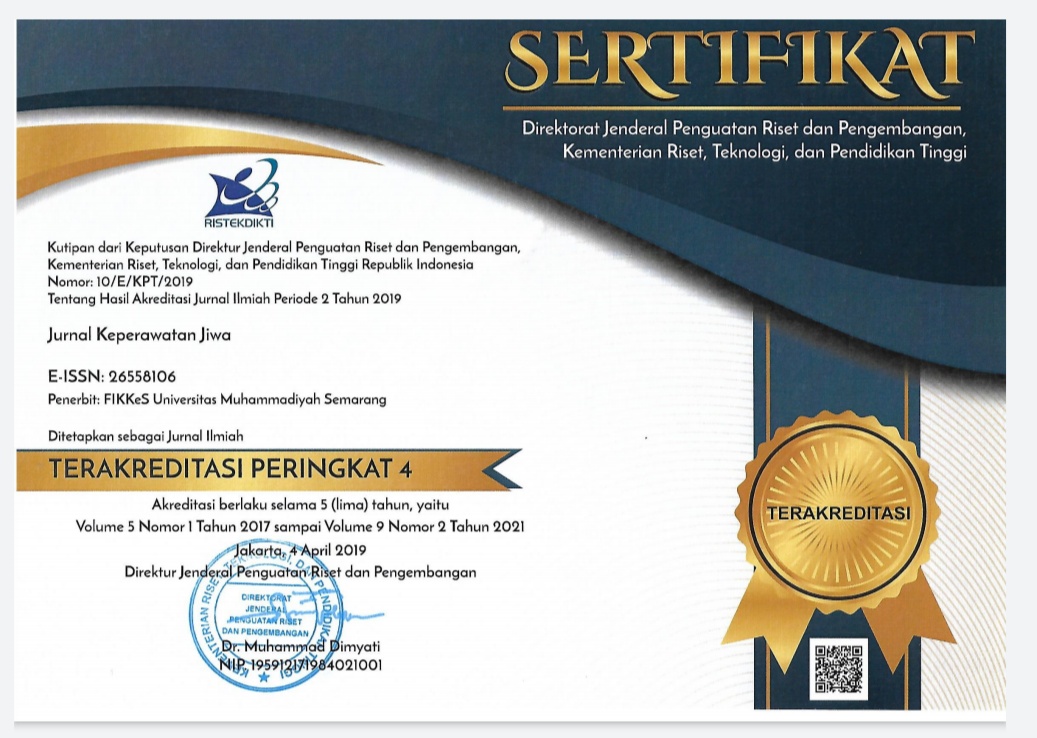Anxiety Levels Related to Flood Exposure in Disaster Victims
(1) STIKes Surya Global Yogyakarta
(2) STIKes Surya Global Yogyakarta
(*) Corresponding Author
Abstract
One of the impacts caused by natural disasters is the increased level of anxiety in the community which, if left unchecked, might disrupt their life cycle. For example, the flood disaster that occurred in Imogiri, Yogyakarta in March 2019 is thought to have increased anxiety in the affected community so that handling efforts need to be done. This study aims to determine the correlation between the level of anxiety and the flood disaster that occurred in Imogiri. The population of respondents in this study were flood victims in Imogiri District. Samples were taken by 68 respondents with a non-probability sampling technique, namely accidental sampling. Data collection has been carried out through a survey using a questionnaire to 68 respondents spread across four villages in Imogiri. Data analysis was performed using the chi-square test. The results showed that there was a significant correlation (p <0.05; r = 0.584) between the level of anxiety and flood exposure in flood victims in Imogiri.
Keywords
Full Text:
PDFReferences
Allred, K. . and S. T. . (1989). The Hard Personality, Cognitif and Psysiological Responsis To Evaluatif Threat. Journal Of Personality and Social Psychology., Vol. 56. N.
American Psychiatric Association. (2013). American Psychiatric Association: Diagnostic and Statistical Manual of Mental Disorders Fifth Edition. In Arlington.
Anonim. (2019). http://bpbd.jogjaprov.go.id diakses 19 Maret 2019.
Arnberg, F. K., Bergh Johannesson, K., & Michel, P. O. (2013). Prevalence and duration of PTSD in survivors 6 years after a natural disaster. Journal of Anxiety Disorders. https://doi.org/10.1016/j.janxdis.2013.03.011
Boe HJ, Holgersen KH, H. A. (2011). Mental health outcomes and predictors of chronic disorders after the North Sea oil rig disaster. 27-Year Longitudinal Follow-up Study. J Nerv Ment Dis 2011; 199:49 - 54. https://doi.org/http://dx.doi.org/10.1097/NMD.0b013e31820446a8
Bromet, E. J. (2012). Mental health consequences of the Chernobyl disaster. Journal of Radiological Protection. https://doi.org/10.1088/0952-4746/32/1/N71
Brooks, S., Amlôt, R., Rubin, G. J., & Greenberg, N. (2018). Psychological resilience and post-traumatic growth in disaster-exposed organisations: Overview of the literature. Journal of the Royal Army Medical Corps. https://doi.org/10.1136/jramc-2017-000876
Buss, A. H. (1995). Personality : Temprament, Social Behavior, and the Self. Boston: Allyn and Bacon.
Depkes, R. I. (2007). Pedoman teknis penanggulangan krisis kesehatan akibat bencana. Jakarta: Depkes RI.
Ramaiah, Savitri. (2003). Kecemasan Bagaimana Mengatasi Penyebabnya. Jakarta: Pustaka Populer Obor
Erawan, W., Opod, H., & Pali, C. (2013). Perbedaan Tingkat Kecemasan antara Pasien laki-laki Dan Perempuan Pada Pre Operasi Lapatorami Di RSUP. Prof.Dr.R.D. Kandau Manado. Jurnal E-Biomedik. https://doi.org/10.35790/ebm.1.1.2013.4612
Fukasawa, M., Kawakami, N., Umeda, M., Miyamoto, K., Akiyama, T., Horikoshi, N., Yasumura, S., Yabe, H., & Bromet, E. J. (2017). Environmental radiation level, radiation anxiety, and psychological distress of non-evacuee residents in Fukushima five years after the Great East Japan Earthquake: Multilevel analyses. SSM - Population Health. https://doi.org/10.1016/j.ssmph.2017.09.002
H, Y. (2019). Hujan Seharian 9 Kecamatan terendam Banjir. www.liputan6.com. Diakses 18 Maret 2019.
Kane, J. C., Luitel, N. P., Jordans, M. J. D., Kohrt, B. A., Weissbecker, I., & Tol, W. A. (2018). Mental health and psychosocial problems in the aftermath of the Nepal earthquakes: Findings from a representative cluster sample survey. Epidemiology and Psychiatric Sciences. https://doi.org/10.1017/S2045796016001104
Kaplan, H.I., Sadock, B.J., Grebb, J. . (1997). Kaplan dan Sadock Sinopsis Psikiatri. Jilid Kedua. Jakarta: Bina Rupa Aksara.
Karanci, A. N., Rustemll, A. (1995). Psychological Consequences of the 1992 Erzincan (Turkey) Earthquake. Disasters. https://doi.org/10.1111/j.1467-7717.1995.tb00328.x
Koentjaraningrat. (2002). Pengantar Ilmu Antropologi. Jakarta : Rineka Cipta.
Kolaitis, G. (2011). Posttraumatic stress disorder in children and adolescents exposed to different traumatic situations: A review of recent studies. European Child and Adolescent Psychiatry.
Lenferink, L. I. M., Nickerson, A., de Keijser, J., Smid, G. E., & Boelen, P. A. (2020). Trajectories of grief, depression, and posttraumatic stress in disaster-bereaved people. Depression and Anxiety. https://doi.org/10.1002/da.22850
Lur Rochman, K. (2010). Kesehatan Mental. Purwokerto: Fajar Media Press.
Marlina Telaumbanua, M., & Nugraheni, M. (2018). Peran Ibu Rumah Tangga Dalam Meningkatkan Kesejahteraan Keluarga. Sosio Informa. https://doi.org/10.33007/inf.v4i2.1474
Musa, R., Draman, S., Jeffrey, S., Jeffrey, I., Abdullah, N., Halim, N. A. M., Wahab, N. A., Mukhtar, N. Z. M., Johari, S. N. A., Rameli, N., Midin, M., Jaafar, N. R. N., Das, S., & Sidi, H. (2014). Post tsunami psychological impact among survivors in Aceh and West Sumatra, Indonesia. Comprehensive Psychiatry. https://doi.org/10.1016/j.comppsych.2012.12.002
Najarian, L.M., Sunday, S. Labruna, V. (2011). Twenty-year Follow Up of Adults Traumatic During Childhood in Armenia. Journal of Affective Disorder : 135 : 51 – 55.
Nugroho, Kharisma, dkk. (2009). PASTI (Perangkat Diagnosa Kesiapsiagaan Bencana di Indonesia). Jakarta : UNESCO Office.
Nugroho, S. P. (2002). Evaluasi dan analisis curah hujan sebagai faktor penyebab bencana banjir jakarta (in Bahasa). Jurnal Sains & Teknologi Modifikasi Cuaca.
Purwastuty. (2019). Kecemasan Masyarakat Terhadap Bencana Banjir Bandang di Desa Batuganda Kecamatan Lasusua Kabupaten Kolaka Utara. Http://Journal.Uin-Alauddin.Ac.Id/Index.Php/Jmks/Article/View/8006.
Rosenberg, S. E. (2014). Posttraumatic Stress Disorder (PTSD). In Encyclopedia of the Neurological Sciences. https://doi.org/10.1016/B978-0-12-385157-4.01074-5
Rufaidah E.R. (2009). Efektifitas Terapi Kognitif Terhadap Penurunan Tingkat Kecemasan Pada Penderita Asma Di Surakarta. Fak. Psikologi UGM.
Scher, C. D., & Ellwanger, J. (2009). Fire-related cognitions moderate the impact of risk factors on adjustment following wildfire disaster. Journal of Anxiety Disorders. https://doi.org/10.1016/j.janxdis.2009.05.007
Shadily, H. (1993). Sosiologi Untuk Masyarakat Indonesia. Jakarta : Rineka Cipta.
Shihab, Q. M. (2002). Tafsir Al-Misbah, Jakarta: Lentera Hati.
Stuart, G. W. & Sundeen, S. J. (2007). Buku Saku Keperawatan Jiwa (edisi 5). Jakarta: Penerbit Buku Kedokteran EGC.
WHO. (2002). The World health report 2002: Reducing risks promoting Health. In Journal of Aerosol Science.
Article Metrics
Abstract view : 600 timesPDF - 46 times
DOI: https://doi.org/10.26714/jkj.8.4.2020.577-586
Refbacks
- There are currently no refbacks.
Statcounter
PPNI Univ. Muhammadiyah Semarang
Jl. Kedungmundu Raya No. 18 Semarang Gedung NRC University of Muhammadiyah Semarang
Phone: 02476740287
Fax: 02476740287
Email: jurkep.jiwa@gmail.com
This work is licensed under a Creative Commons Attribution 4.0 International License.


